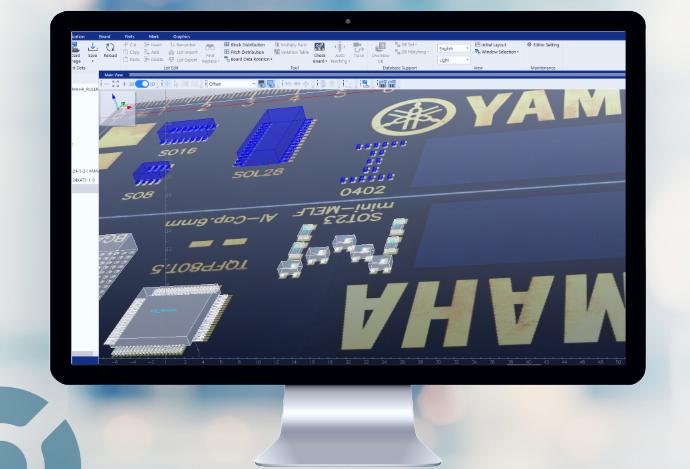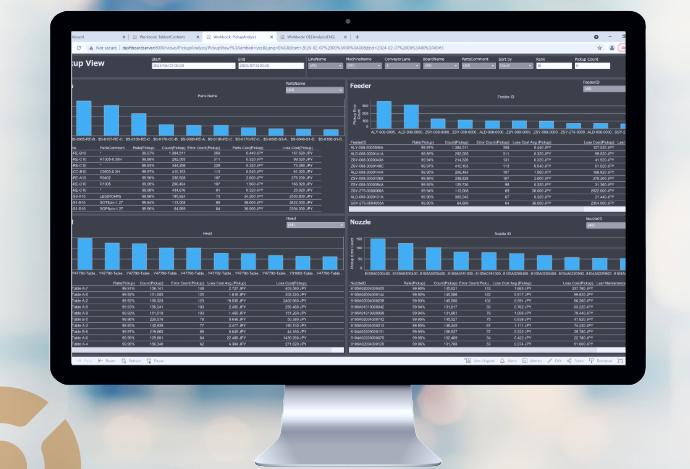For PCB assembly professionals: Explore the advantages of Yamaha Intelligent Factory
The intelligent factory works with production teams, through powerful software tools, to raise productivity by improving production plans, minimizing stoppages, and accelerating troubleshooting
5 workflow advantages by using Yamaha Intelligent Factory
Yamaha intelligent factory
Achieving production targets & waste reduction by swiftly supplying the production team with key information

Waste comes in many forms that impair overall efficiency. The smart factory combats these, including helping with time-consuming tasks to ensure faster turnaround for customer orders and assisting with machine programming and setup to accelerate new product introduction (NPI) and ensure optimum utilization. The intelligent factory also cooperates to anticipate problems such as equipment errors or depleted component feeders and thus ensure continuous, efficient production and the highest possible end-of-line yield.
Seen in this way, the intelligent factory defines a production facility endowed with advanced tools that provide intuitive support for planners and production teams to ensure every shift can attain optimal productivity.
Of course, much of the added value in the smart factory is associated with software-based tools that assist with planning and optimization as well as managing processes and responding in real-time to issues that arise during production.
Yamaha Intelligent factory
Component data creation at the next level
The incoming generation of smart factory tools help accelerate laborious and time-consuming processes such as component data creation.
Example:
Yamaha’s YSUP-PG visual data editor, which assists by displaying component data and graphical images at the same time to simplify processes like creating and editing component identities.
This saves programmers having to switch back and forth between different screens, memorizing the information each time, which is a familiar pain point.


On desktop trial mounting helps you ensure components are setup to be correctly oriented relative to the land design long before boards start being built. Leveraging advanced 3D rendering on high-performance graphics processors can visualize how the completed assembly will look in greater than ever before (figure 1).
It can highlight any issues that may need to be addressed, in a way that earlier programming environments simply would not be able to achieve. In the past, inaccuracies in component data may have gone undetected until the first boards reached inspection or test.
In addition, production equipment such as component mounters can support data creation by helping automatically generate component pickup data.
Figure 1. 3D graphics can show details such as relative heights of adjacent parts, which helps identify any problems with the data.
Yamaha Intelligent factory
Software tools optimize production planning, setup & SMT line performance
Smart factory tools provide enhanced capabilities for optimizing production efficiency and equipment utilization.
Planners have long sought to consolidate the production of assemblies that can use the same solder type and reflow profile, to save changes to printer and oven settings. Waiting for reflow zone temperatures to stabilize in between product changeovers can be particularly time consuming, causing extended line stops.
Identifying products that can be built together to enhance efficiency and minimize the time spent setting up and changing over products is difficult to achieve, as it require that the production planner consider so many parameters simultaneously.
The YSUP-PG line optimizer tool applies an algorithm that minimizes production loss due to setup work and can adapt depending on the different capabilities of the various equipment models in the line.
Also, the YSUP-PG Production Planner has a grouping function that can assign products in groups according to common components and equipment settings, also taking into account their production schedules and shipping plans.
The operator can direct the grouping process and select priorities, relying on the tool to do the number crunching. Compared to manual grouping, automation improves critical indicators such as the number of group changeovers needed, and numbers of carts and feeders needed, by 25%.
On the other hand, automation has saved more than 80% of work time committed to data preparation.

Another factor that can be improved with automation is material time limit management.
Materials that have a finite lifetime on the production line, such as solder paste and moisture-sensitive components, can easily exceed their maximum exposure if the expiry time is tracked manually.
Smart factory tools hand responsibility to machines in the line, to identify and reject expired parts to ensure all assemblies are built according to the specified standards.
Yamaha intelligent factory
Production analytics during & after PCB assembly
While production is running, the smart factory provides real-time assistance by actively monitoring progress and ensuring materials are retrieved from inventory and directed to the right places at the right times. It ensures production can run continuously without stoppages and informs operators of issues that need attention.

Figure 2. The analytics dashboard helps quickly solve the causes of pickup errors.
Leveraging cutting-edge data analytics provides the foundation for tools that take the guesswork out of defect analysis.
Using the YSUP suite again as an example, this tool has recently updated the main Dashboard user interface by introducing component pickup analysis (figure 2) that automatically identifies the causes of any defects detected. It tracks errors by head, feeder, and nozzle, and then checks the status of other parts assigned to the same feeder and nozzle to determine whether the problem is caused by the equipment or the component.
The
tool can do this in near real-time, which saves production
supervisors puzzling over how to fix problems,
relieves the overheads of trial-and-error troubleshooting, and helps quickly
restore maximum productivity.
Ultimately, this enables every
working shift to deliver consistently high production throughput and
end-of-line yield, and significantly reduces stoppage time.
The Dashboard’s pickup error analytics goes further than simply highlighting causes and cures, however, by also identifying frequently occurring errors and calculating the costs of component losses to help prioritize remedial action. Maintenance teams also benefit from rich information about feeder and nozzle issues, pickup performance, and trends, to help pinpoint the causes of errors remotely and predict optimum times for repair or recalibration.
Yamaha Intelligent Factory
Yamaha Intelligent Factory is made smarter with connectivity
There
would be no smart factory without coordination between the manufacturing
activities and the enterprise software directing business operations at a high
level.
Collecting data from factory equipment enables analytical applications
in the IT domain to enhance business planning and direct continuous
improvement. Modern APIs like JSON and REST enable the IT and operational
domains to communicate and share data.
Yamaha’s YSUP-LINK connectivity package for smart factories supports these APIs and is also fully certified according to the IPC-CFX open standard for machine-to-business and business-to-machine communications.
The advantages of Yamaha Intelligent Factory conclusion
The principles driving the transition to intelligent factories aim to automate conventionally laborious and complicated tasks. Powerful software tools that utilize the latest data analytics techniques, are key enablers of the change, which can boost productivity by cutting new-product introduction time, enhancing manufacturing efficiency and equipment utilization, and helping to avoid or minimize the impact of any errors. Now the smart factory has arrived, the scene is set for future generations of software tools to further accelerate progress.
For PCB assembly professionals: Explore the advantages of Yamaha Intelligent Factory